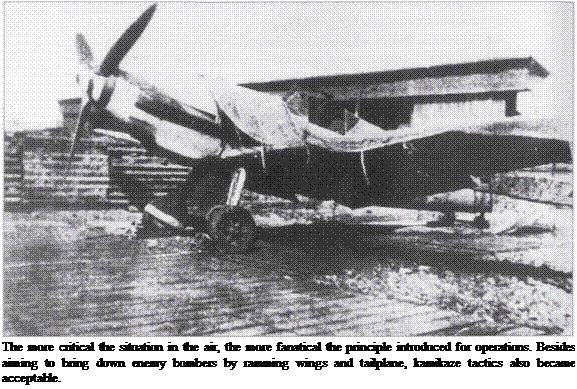Operation Freiheit – Flight to Death
Once the situation on the Eastern Front had become completely hopeless during April 1945, volunteers for suicide operations – more committed than ever before – made themselves available. Every effort now seemed justified if only to buy a few more days. Whether this might allow time for the ‘Miracle Weapon to be ready was irrelevant. Towards the end of January 1945 when the Red Army had reached the Oder, the Luftwaffe had been told to ‘exhaust every means’ to halt the enemy advance. When the offensive against Berlin began on 16 April 1945, the German pilots took off on previously planned missions against bridge targets.
For this purpose ‘suicide squads’ stood ready at the Altes Lager airfield Magdeburg and on other airfields near Jiiterbog in mid-April 1945. About 40 volunteers with varied operational experience and flying knowledge had gathered there and in the face of the Russian offensive were ready to do and die. Generalmajor Fuchs gave SO Group A their orders on the evening of 15 April after briefly explaining the general situation. In the late afternoon of the next day, pilots of III./JG 3 flying Bf 109 F, G and К fighters led the way east for the suicide squad. The SO Group machines were each armed with a 500-kg bomb. Since there were too few single-engined machines available for all pilots, those without an aircraft were transferred to SO Group B. The objectives were the pontoon bridges over the Oder at Kiistrin and Frankfurt. Young officers and

NCOs dived their aircraft into the targets. The pilots of the escort machines saw impact explosions. These ‘total missions’, as described later in the War Diary, resulted in numerous hits on the bridges, air reconnaissance reporting an 80- metre long gap between sections in one of them.
On 19 April 1945 a total of 36 ‘SO’ single-engine machines took off for the Oder. A number of volunteers fell victim to Soviet fighters or anti-aircraft fire. Because of the prevailing weather conditions and smoke screening the bridges, three pilots could not find the target and returned to base. That night the Luftwaffe Command Staff put a stop to the operations. Since pontoon bridges could be repaired or replaced almost overnight, supply lines to the Red Army forward units were not seriously affected. The operations and their toll in Luftwaffe dead had little effect on events.
The Red Army was now advancing on a broad front from Cottbus towards Berlin and reached the Jiiterbog area on 24 April. The last 13 pilots of SO Groups A and В received orders by telex to transfer to II./SG 2 Immelmann which remained in action under Oberst Rudel to the end. Most men got through to the airfield at Kummer am See in Bohemia and reported to their new unit. Their operations lasted until 7 May.
The concurrent attacks of the Mistel combinations of II./LG 1 resulted mosdy in near misses, the immense groupings of Russian anti-aircraft batteries around the bridges preventing accurate bomb-aiming.
Pilots of anti-tank special Staffeln also apparently participated in what amounted to suicide actions. Many committed themselves to especially risky missions by a simple handshake. Some of the Вії 181 aircraft at Magdeburg were converted into makeshift bombers by removing the right-hand seat, cutting a hole in the fuselage with saw and shears and inserting a tube to hold a 50-kg bomb. Six of the 14 mosdy young pilots who took off on 20 April 1945 failed to return: Leutnant Schwarzer, Fahnriche (Ensigns) Bethe, Hauber and Fleisch – mann, Unteroffiziere Kleemann and Scholl. Some of the Bii 181s from Magdeburg carried two 50-kg bombs, and the pilots dived into the target to ensure that they exploded simultaneously. No further details are known.










